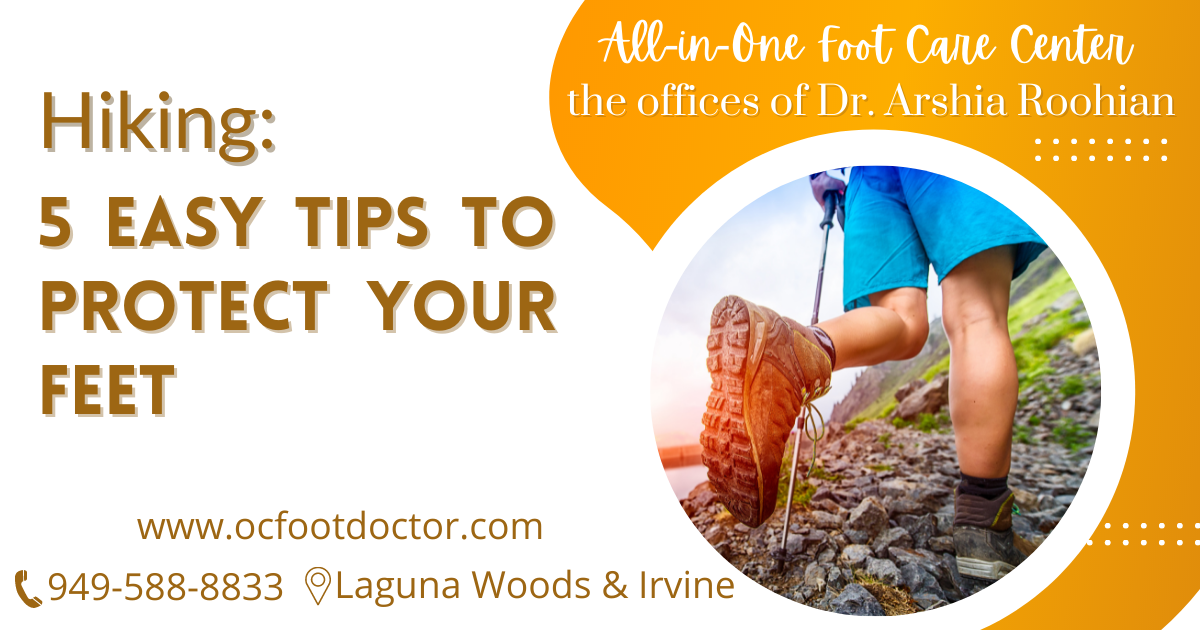Hiking: 5 Easy Tips To Protect Your Feet

Hiking is an incredibly enjoyable activity. It is common for hikers to feel more connected to nature and to gain fitness benefits. In general, hiking is a more gentle form of exercise than running but still has a cardio benefit.
Besides getting off the beaten path, hikers get to explore and mix and match trails to keep things interesting. Fortunately, there are lots of resources available to help you find trails and things to see along the way.
No matter where you live, hikes can often be found and accessed easily, whether you live in the city or in the country.
We'll now talk about the feet
Let's talk about the feet now, since they take the brunt of the impact when you hike. We see many knee and ankle injuries among hikers, and we'll discuss those in future articles. Most of the time, though, you will have minor, annoying problems with your feet that will make the hike less enjoyable.
These are simple, yet effective, ways to protect your feet:
- TIE YOUR BOOTS PROPERLY
Boots should be properly laced to prevent blisters. To ensure a snug fit and prevent the feet from sliding around, tighten the laces gradually from the bottom up. - WEAR WELL-FITTED, BROKEN-IN BOOTS
A local outfitter with experience in hiking gear is the best place to get your boots fitted. After looking at your feet, they can tell you what type of boot will be most supportive for your foot type. If you are hiking in a certain style, they might also make recommendations.
Once the boot is loosened up, "breaking-in" your boots is worth the effort. In contrast to traditional leather boots, some of the modern hiking boots take little to no breaking in.
In addition, many hikers wear "trail-runners" that combine excellent support and flexibility with the comfort of a sneaker. Before settling on a pair of shoes, don't be afraid to try a few. - KEEP YOUR TOENAILS CLIPPED
It's pretty self-explanatory. It may seem simple, but disregarding your toenails will end up costing you. Smashed toes can result in an array of problems, especially for those who attempt long through-hikes. - WEAR PROPER SOCKS
Don't skimp on your socks. Avoiding blisters is as easy as wearing well-fitting socks. Putting on old socks that don't fit is like not brushing your teeth - it's ok for a short while, but it's going to become really uncomfortable.
Your socks should be made of quality material. Over the last few years, fabric technology has evolved greatly. On your hike, you don't need to wear old-fashioned cotton socks. Currently, Merino wool is the gold standard, which provides great moisture control and comfort for your adventures. - TREAT BLISTERS AND HOT SPOTS EARLY
Every hiker complains about blisters and hot spots. Blisters may seem insignificant initially, but they can lead to all sorts of pain in the long run. Taxes and awkward conversations are things that should be handled head-on because putting them off will only make them worse.
Blisters are mostly caused by friction, which is why you should wear broken-in boots and good socks. Blisters are sometimes unavoidable. Here's how to deal with them:
** Once you notice a blister, tape it with moleskin.
** Sprinkle foot powder on the blister to keep it dry.
** Make sure you pack high-performance sandals in your daypack. You could switch to sandals if you're getting blisters, which are easier on your feet.
You shouldn't let little problems with your feet slow you down. You will enjoy your time on the trail much more if you observe some of the precautions mentioned above. If you are experiencing any pain in your feet, All-in-One Foot Care Center is here to help! You can contact our office at949-588-8833, or visit our website at https://www.ocfootdoctor.com. Our offices are located in Laguna Hills, Irvine, Mission Viejo, Aliso Viejo, Lake Forest, Foothill Ranch, and Costa Mesa.
🏢 24331 El Toro Rd, Suite 370 Laguna Woods CA 92637
🌐 https://www.ocfootdoctor.com/


